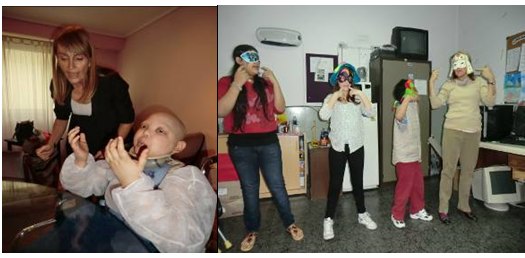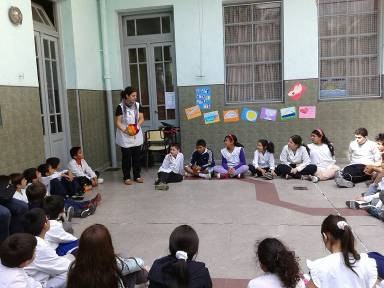The English Speaking Body in the Empty Space: Using our Free Resources in a Resource-less Classroom
Susan Hillyard, Argentina
Susan Hillyard, B.Ed. (Hons) Warwick University U.K. Susan has work experience in seventeen countries as a teacher, HOD, director, speaker, workshop facilitator, consultant, researcher, on-line tutor. She was Prof. Language IV in Lenguas Vivas and UTN Teacher Training Colleges, Bs As., Argentina. She has co-authored a Resource Book for Teachers Global Issues for OUP and TDI-TKT On-line Course for Pearson, New York. Tutor on-line Masters in ELT for Language and Globalisation at La Sabana University, Colombia. SEN Network coordinator and commitee member YLTSIG for IATEFL.Coordinator: English in Action, teaching English through Drama using ActionSacks in Special Education, Ministry of Education, City of Buenos Aires, Argentina. Member of the C-Group.
E-mail: ssnhillyard@gmail.com
blogspot: http://susanhillyard.blogspot.com.ar

Menu
Background
A lesson plan
References
English in Action is a programme designed to teach English through educational drama techniques to students with specific needs who are at primary level in state special education. It is designed by a co-ordinator and implemented by a group of 15 teachers contracted by the Department of Special Education, Ministry of Education, City of Buenos Aires, to promote inclusion and equal opportunity for students presently attending special schools. These students have never been exposed to any formal English classes in their state education system so far, but if and when they are included in mainstream, they will be in a class with students of the same age who may already have completed between one and four years of English language classes.
English in Action is aimed at learners between five and sixteen years of age, attending twenty remedial schools, shantytown schools, hospital schools, orphanages and transplant units, as well as children receiving home tuition in the City of Buenos Aires. These students may have phobias; dyslexia; emotional disorders; ADHD; physical impairments; general learning difficulties; long term illnesses such as cancer, HIV, or waiting for heart or liver transplants and therefore cannot attend regular school for a long period of time. We are currently working with nearly 500 students in 26 establishments scattered all over the city. The emphasis is on developing the listening and speaking skills and using educational drama techniques to develop confidence, self-esteem and fluency. The definition of educational drama includes role play, improvisation, song, story, music, Total Physical Response, art and craft, puppets and language games. It is about developing language through the use of creativity and moving the students on the inside and the outside into imagined worlds. It is about making the learning of English a joyful process. It is based on the concept of “The Speaking Body in the Empty Space”.

Every lesson at schools is conducted in the magic circle (with or without chairs) with no desks, pens, paper or books so we really use the Speaking Body in the Empty Space. Every teacher designs and makes an ActionSack on a particular theme, jam packed with English in Action activities. The teacher joins in but tries to take a back seat role to have the students being the protagonists.
Aims
Every lesson plan has the aim of:
1) Developing the SPICE of ELT and must cover the five developmental areas of the growing learner through using English as a vehicle for Action:
S for Social development
P for Physical development
I for Intellectual development
C for Creative development and
E for Emotional development
|
2) Using a springboard e.g. a story/song/video/poster to develop the listening and speaking skills of basic language, in this case “Magic Spells”.

Section 1 Introduction
Warm-up: Breathing, Brain gym, Body and Voice Preparation. (BBBV)
- Explain, possibly in the L1, that all actors in the theatre and in films always start with this kind of warm up and that we will start every class like this.
- Stand in a closed circle. Hands on diaphragm. Breathe in through the nose and out through the mouth to the count of 2, then 4, then 8, then 16.
- Using first the right then the left arm, then the right leg, then the left leg... shake the limb in the air to the count of 8, then T shouts HALF, so to the count of 4 then T shouts HALF, so to the count of 2, and then T shouts HALF, so to the count of 1
- Shake the hands and fingers x 8. Stretch high, high, high (raising your voice). Push down low, low, low… (lowering your voice.) Relax. Clasp hands and push them into the circle in front of your stomach….clasp hands behind your back and do the same pushing back……clasp hands and push up to the ceiling. Raise right arm above your head and lean as far as possible to the left…repeat with left arm. Make big circles with your arms at the side of your body, first forwards then backwards to the count of 4 then 8 then 16.
- Imagine there’s a monster on the roof with 6 little helpers, throwing down strong glue that attaches itself to your fingers….they go UP, UP, UP (raising your voice) Then the monster runs down into the basement and your fingers are going DOWN, DOWN, DOWN (deepen your voice)
- Ask individual students, maybe in L1, “What colour was your monster?”
- All place their arms folded in front of their chests with one hand placed flat on top of the other.
- T raises her right hand to her forehead as she makes different vowel and consonant sounds with the students following both sounds and movements.
- Repeat N° 7. but make dramatic sounds like ahhhhh…..ohhhhhh…..ooooooo… mmmmmm…..orrrrrrrrr…geeeeee…wooooooow…noooooooo…etc
- Choose a sound and everybody breathes in to the count of 8 and starts to enunciate their sound and keep it going as long as possible.
Section 2 Core
The springboard: A “story”
The teacher, a dramatic storyteller, showing the illustrations from an illustrated story and having the students looking carefully at the pictures (or flashcards) to gain meaning, engages the class with the springboard.
The teacher picks out specific vocabulary, expressions, structures she wishes to emphasise and has the class repeat them with the essential actions. Generally she extends the basic drill to say them happily, sadly, angrily, crying, laughing, fast, slow etc.
Often the teacher will mime or demonstrate the meaning and sometimes use L1 to explain meaning.
Section 3 Development
Magic Spells with realia: A witch’s hat and a wand
The T thinks of a list of animals which make definite and clear animal sounds e.g. lion, monkey, duck, snake (not fish!).While waving the magic wand and wearing the hat the T casts the spell:
“I touch my nose, I touch my ear, and abracadabra, everybody is a TIGER here!”
(Magic wand helping in the “spell”)
The spell may be cast on the whole group or on individuals. e.g. “I touch my nose, I touch my ear and abracadabra, “Marcos is a MONKEY here”
On the word “here” the students mime the animal and make the animal sound. Call out FREEZE. Take photos if you wish. Then cast a new spell. This can be done with human sounds e.g.”…is laughing/crying/ shouting/ here” or “is in a factory/street/ market “ etc.
Have a student take on the role of Teacher to cast the spell.
Section 4 Conclusion
Winding down and saying goodbye
- Living spidergrams:
Ask for “hard” vocabulary from the story and pass a ball/bounce a ball around the circle asking students to contribute a word they can remember:
T: Magician
St 1: Witch
St 2: Frog
St 3: Rabbit
St4: Monkey
- Sing the goodbye song with actions.
Baldwin, P. (2004). With Drama in Mind. Stafford UK: Network Educational Press.
Baldwin, P. & Fleming, K. (2006). Teaching Literacy Through Drama: Creative Approaches. New York, USA: Routledge Falmer.
Bolton, G. Towards a Theory of Education, in Morgan, N. and Saxton, J. (1987:21), Teaching Drama, A Mind of Many Wonders. Gloucester, UK: Thornes, Nelson,
Cummins, J. & Swain, M. (1986). Bilingualism in Education. UK: Longman.
Di Pietro, R. J. (1987). Strategic Interaction , Cambridge, UK: Cambridge University Press.
Fisher, R. (1998). Teaching Children to Think. Newcastle UK: Stanley Thornes
Macgregor C. Magic Spells, (2007). Loughborough, UK: Ladybird Books Ltd.

Please check the Creative Methodology for the Classroom course at Pilgrims website.
Please check the Drama Techniques for Creative Language Teaching course at Pilgrims website.
Please check the Dealing with Difficult Learners course at Pilgrims website.


|